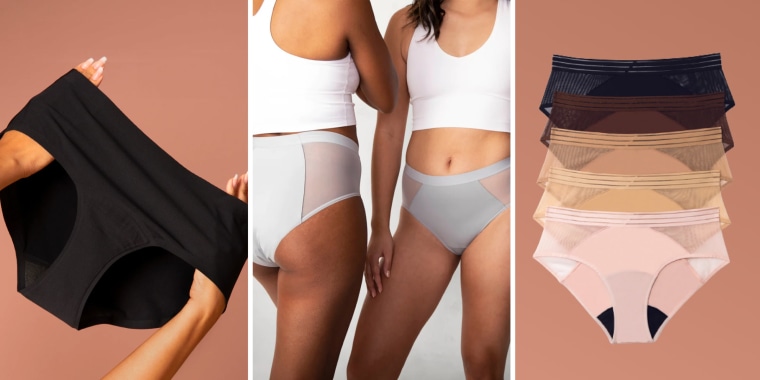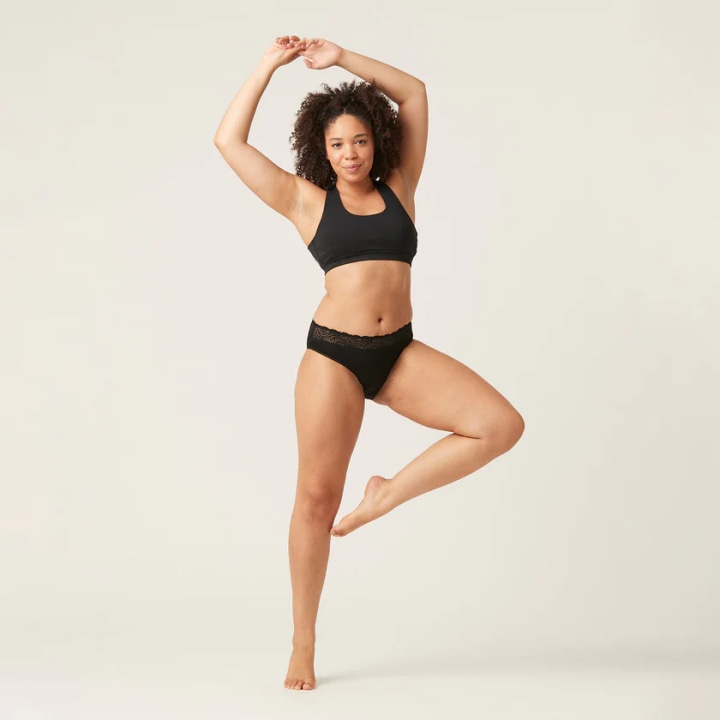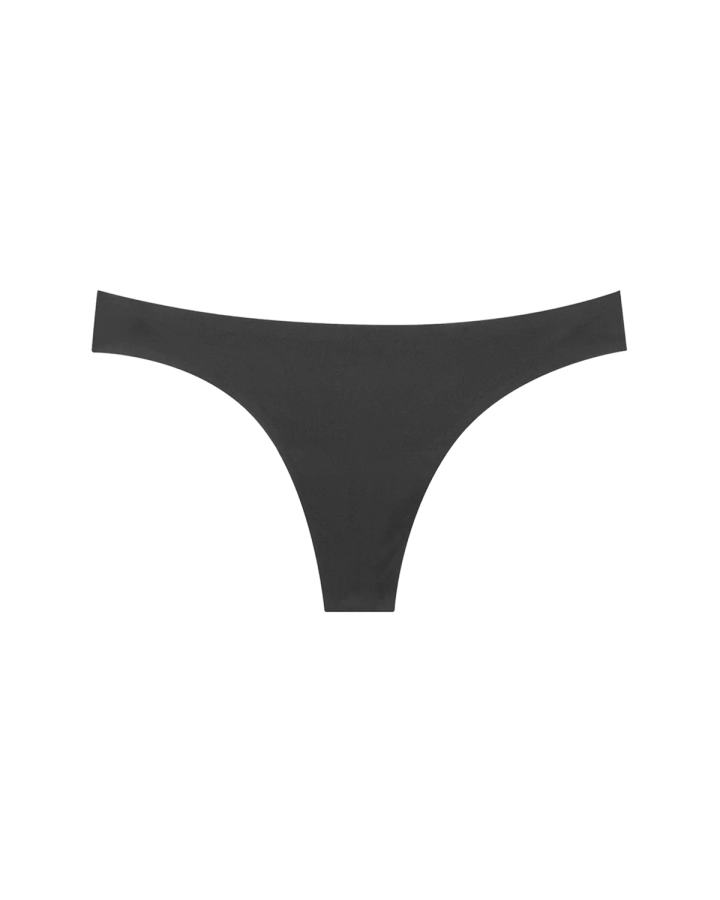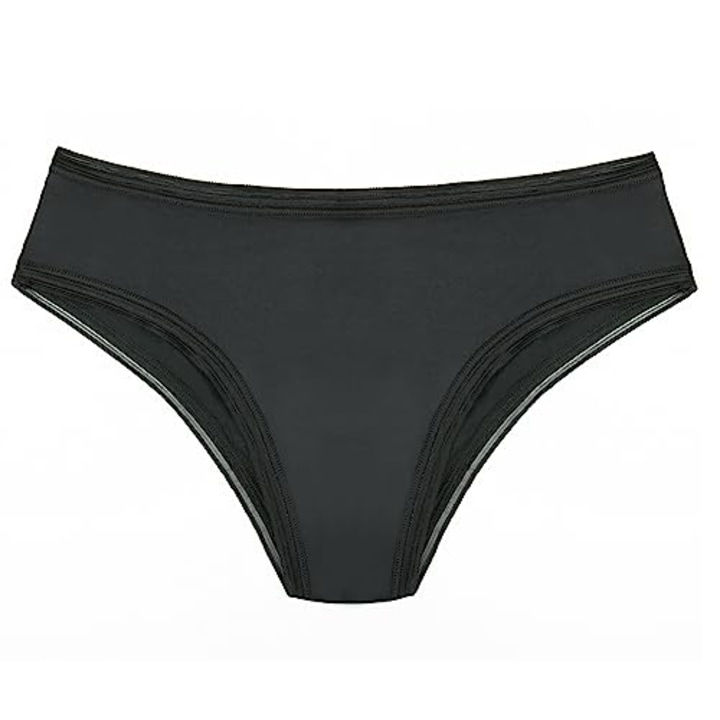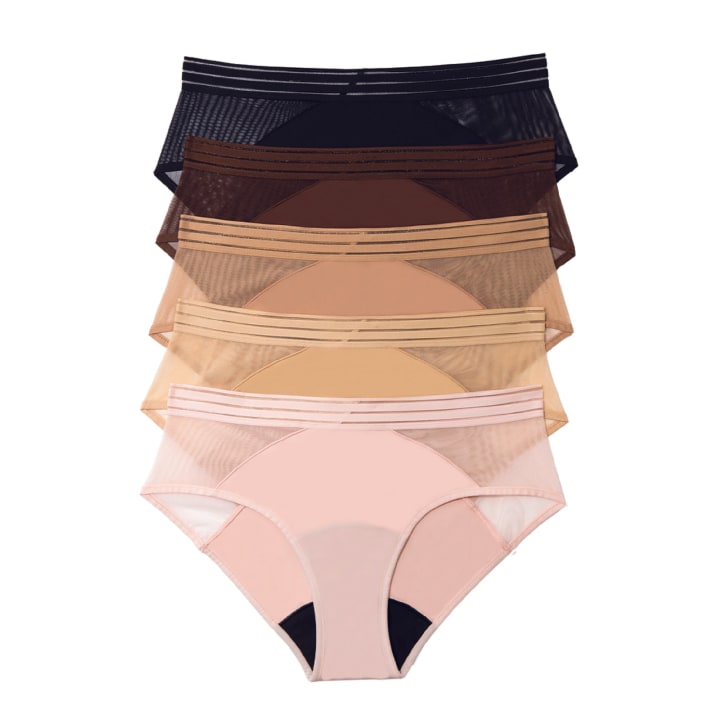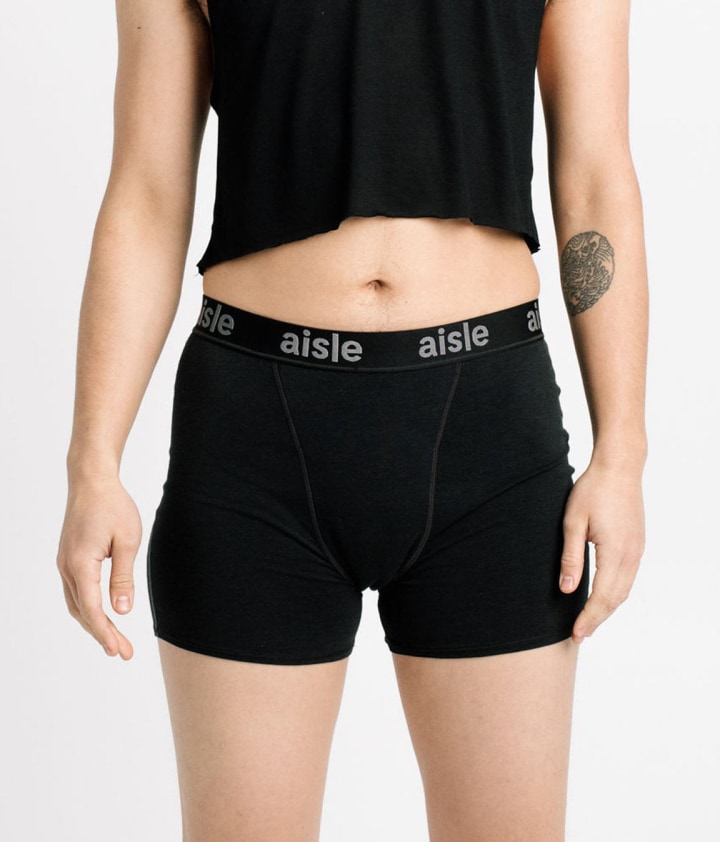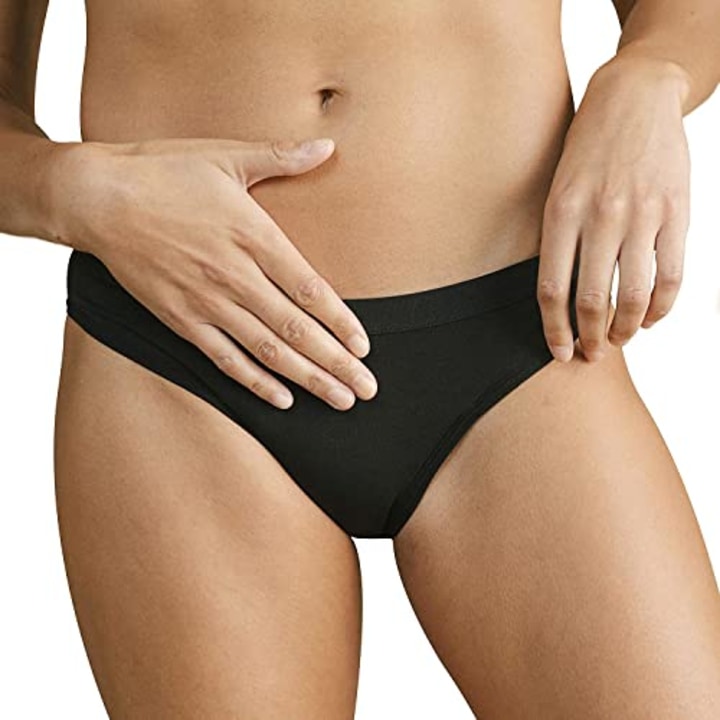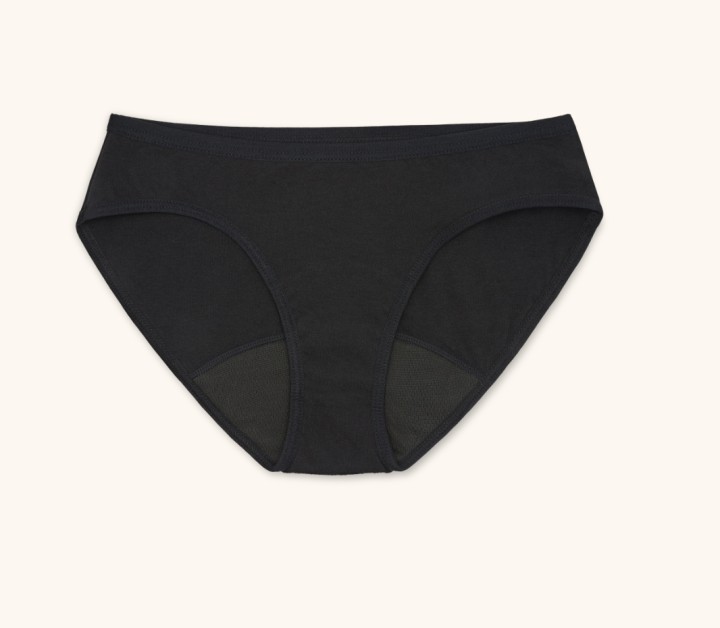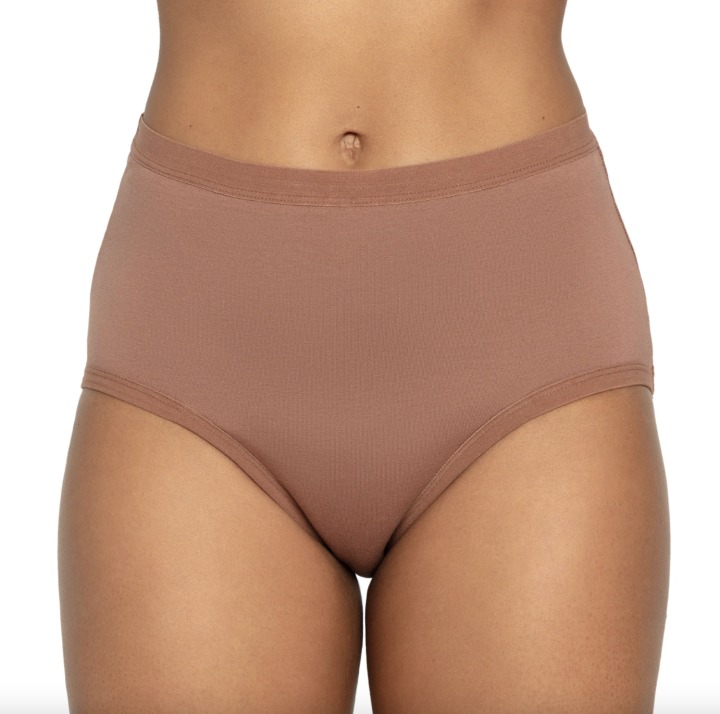While pads and tampons have reigned supreme since around the 1930s, alternative menstrual products — including period underwear, menstrual cups and discs — have gained significant traction in the past few decades. Interest can be attributed to several factors, including shoppers valuing sustainability, cost effectiveness and more willingness to talk about menstruation in general.
“As folks begin to talk more openly and more often about menstruation and menstrual health, they share options beyond what they assume to be the one and only method of care — typically commercial pads and tampons,” says Chris Bobel, professor of women’s, gender, and sexuality studies at the University of Massachusetts, Boston.
Period underwear is reusable, designed to handle the different flows throughout your period and helps those who menstruate move away from traditional disposable pads. In fact, Google searches over the past year show that interest in period underwear is higher than interest in period pads and menstrual cups (tampons still take the top spot). And unlike “period panties” that keep pads in place during that time of the month, period underwear can act as either a worry-free backup to a tampon, cup or disc or take the place of tampons and pads altogether.
To better understand how period underwear works (and whether they’re safe to use), we spoke to gynecologists about its advantages, limitations and best uses. We also gathered some highly rated options to consider based on their guidance.
SKIP AHEAD Top period underwear to shop | How to shop for period underwear | Is period underwear worth it? | Is period underwear safe?
Our top picks
- Top light absorbency: ModiBodi Sensual Hi-Waist Bikini
- Top moderate absorbency: Saalt Leakproof Mesh Hipster
- Top high absorbency: Knix Super Leakproof High Rise
What exactly is period underwear?
Period or menstrual underwear is specially designed to absorb menstrual blood, so you rarely need to use pads, tampons or cups in conjunction with it, according to Dr. Andrea Zuckerman, chief of pediatric and adolescent gynecology and vice chair of gynecology at Tufts Medical Center. It’s designed to look like normal underwear: You’ll see period underwear offered in all sorts of styles, including boyshorts, bikinis, briefs and thongs.
While period underwear may resemble any other standard pair, it has a built-in pad with a moisture-wicking top layer that draws away wetness and dries fast, plus a super absorbent core layer, says Dr. Carolyn Moyers, a board-certified OB/GYN and founder of Sky Women’s Health.
A lot of period underwear is made from cotton and absorbent microfiber polyester, with some nylon or elastane thrown in for stretch and durability, according to our experts. Best of all, you usually can’t even tell there’s a pad built in — there’s little bulging and you don’t have to deal with the annoying issues that come with traditional pads, such as adhesive and wings.
How we picked the best period underwear
Below, we highlight the top factors our experts recommend keeping in mind when shopping for period underwear.
- Absorbency level: There are three main absorbency levels for period underwear: light, moderate and high. Most period brands determine the absorbancy level by how it compares to regular tampons, which our experts say typically hold up to 5 milliliters of blood each (though this varies by brand). Some of the most absorbent period underwear on the market can hold more than five regular tampons’ worth of blood, says Moyers. Based on our experts’ guidance, we considered light absorbency to be similar to one to two tampons, medium absorbency to be similar to three to four tampons and high absorbency to be equal to five or more tampons.
- Material: Look for moisture-wicking fabrics like nylon and polyester, which absorb wetness and dry quickly.
- Maintenance: Consider period underwear that’s machine-washable, which makes it easier to clean and reuse.
- Fit: Period underwear comes in a variety of styles that mimic your typical underwear you would wear everyday, including full-coverage, cheeky, thongs and boxers. Consider the style that fits best for you and your lifestyle.
- Ratings: We compiled period underwear with a 4-star average rating or higher across hundreds of reviews on the brand’s website or at major retailers.
Top-rated period underwear to consider
We separated the following pairs of highly rated period underwear into three categories according to absorbency level, per our experts’ guidance: light, moderate and heavy coverage. Each of the following period brands indicates its underwear’s absorbency level (either based on number of regular tampons, volume in milliliters, or both) and all underwear options are machine-washable.
Light absorbency period underwear
ModiBodi Sensual Hi-Waist Bikini
ModiBodi sells underwear for a variety of needs, including everyday, pregnancy and moisture-wicking. The brand’s period underwear is among its most popular pairs, and the Sensual Hi-Waist Bikini has earned an 4.9-star average rating from more than 3,100 reviews on its site. This bikini-style underwear is meant for lighter flows — about the same absorbency as two tampons — and is designed to sit right at the hip with a higher leg. The brand also offers a moderate-heavy pair that’s similar to two to three tampons, a heavy-overnight option that’s similar to three to four tampons, and a maxi version, which absorbs the same amount of blood as 10 tampons, according to ModiBodi.
The underwear has a high-waisted fit and a lace trim, and it comes in seven colors and patterns. The bikini-style underwear is also made with a stain-, odor- and bacteria-fighting lining, according to the brand. It’s available in five colors, including beige, moss green and black, and in 10 sizes ranging from XS to 6XL.
Absorbency: 1-2 tampons (10 mL) | Sizes: XS to 3XL
Proof Leakproof Thong
Like Modibodi, period label Proof designs underwear for different needs, including postpartum, workout and maternity. The Leakproof Thong has the absorbency of about one tampon and is designed to both help with light leaks and erase panty lines, according to the brand. The pair is made from what Proof describes as a breathable microfiber and comes with a low-rise silhouette. You can use this period underwear in conjunction with a tampon because it’s primarily meant for spotting, sweat and other discharge, according to Proof. It has a 4.9-star average rating from over 70 reviews at Proof and it’s available in two shades: black and sand.
Absorbency: 1 tampon (10 mL) | Sizes: XS to 3XL
Thinx Cheeky
Thinx is one of the more well-known period underwear brands with lines designed for different ages and lifestyles, including one for tweens and teens called Thinx (BTWN) and another for bladder leaks called Speax. (Thinx recently settled a class-action lawsuit claiming the brand’s underwear contains harmful chemicals. Thinx denies these claims and admits no guilt or wrongdoing. We go more in-depth about this below.)
Made from flexible nylon and elastane, this cheeky-style underwear, as well as the brand’s thong, has Thinx’s lightest absorbency level: up to one tampon’s worth of blood, according to the brand. Thinx also offers styles in four additional absorbency levels, including light (two tampons), moderate (three tampons), heavy (four tampons) and super (five tampons). The Thinx Cheeky has a 4.8-star average rating from over 1,000 reviews at Thinx.
Absorbency: 1 tampon | Sizes: XS to 4X
Moderate absorbency period underwear
Saalt Leakproof Mesh Hipster
Saalt, one of our favorite women-owned brands, is best known for its popular menstrual cups. But the brand also has a period underwear line called Saalt Wear, which includes bikinis, thongs and briefs aimed at absorbing periods, bladder leaks and more. The Leakproof Mesh Hipster, which has a 4.4-star average rating from over 200 reviews at Saalt, is designed to absorb as much as two to three regular tampons’ worth of blood, according to the brand. This pair is made from sheer mesh and offers a stretchy, mid-rise waistband. It comes in five colors, including desert sand, black and warm stone.
Absorbency: 3 tampons | Sizes: XS to XXL
Aisle Boost Boxer
The Boost Boxer is designed with a statement waistband displaying the brand’s name along with an absorbency that matches up to four tampons, according to Aisle. The underwear comes with a booster that you can tuck into the ends of the gusset for even more protection — the same as four additional tampons, or a total absorbency similar to eight tampons, according to the brand. The underwear has over a 4-star average rating from more than 600 reviews at Aisle and comes in four colors: black, beet, ginger spice and kelp forest. In addition to period underwear, Aisle also offers its own line of liners, pads and cups.
Absorbency: 4 tampons (8 tampons with booster) | Sizes: XXS to 5X
Cora Period Underwear
Eco-friendly tampon and pad company Cora, which makes some of our favorite menstrual cups, also makes period underwear that it says absorbs the same as three regular tampons. The underwear — which has a 4.2-star average rating from over 900 reviews on Amazon — is designed to be flexible, especially for those with active lifestyles, according to the brand: It has a moisture-wicking core and elastane to make it stretchy and comfortable. It’s available in sizes XS to XXL and in packs of one, three or five.
Absorbency: 3 tampons | Sizes: S to XXL
Rael Bikini Reusable Period Underwear
Rael offers three underwear styles, each with different absorbency levels: a bikini style that can absorb as much as three tampons’ worth of blood, and high-waisted and boyshort styles that both offer up to five tampons-worth of protection, according to the brand. Meant to look and feel like everyday underwear, it’s made with four layers, including one from breathable cotton and another that’s meant to protect against moisture and odors, according to Rael. The brand recommends changing it after 5-8 hours of use. You can choose to bundle the underwear in a pack of one, two or three pairs.
In addition to period underwear, Rael carries its own collection of menstrual cups, pads, tampons and panty liners. Like the other options on this list, Rael’s period underwear is highly rated, with a 4.5-star average rating from over 30 reviews at the brand’s site.
Absorbency: 3 tampons | Sizes: S to XXL
High absorbency period underwear
Knix Super Leakproof High Rise
Knix’s period underwear falls into two categories: light-medium and heavy coverage, the latter of which is equivalent to eight tampons’ worth of protection, according to the brand. The Super Leakproof High Rise is among its most popular offerings: It has an average 4.6-star rating over more than 4,200 reviews on the brand’s site. The pair comes with an extended gusset that’s 9 inches long and four-way stretch that’s meant to create a more comfortable fit the more you wash and wear it, according to Knix. In terms of fit, this underwear sits at the natural waist. You can choose between 11 colors, including rose water (pink), orchid (light purple) and midnight (blue).
Absorbency: 8 tampons (40 mL) | Sizes: XS to XXXXL
The Period Company The High Waisted
As its name implies, The Period Company is centered around period underwear (the brand also offers reusable pads and panty liners that are more recent additions). Made with organic cotton and spandex, this high-waisted pair can hold up to 10 tampons’ worth of blood and lasts an average of 8 hours for a heavy flow, according to the brand. Along with The High Waisted, which earned a 4.2-star average rating from over 1,600 reviews on the brand’s site, you’ll also find The Bikini with a lower rise, The Boxer and The Adaptive Bikini, which has velcro closures.
Absorbency: 10 tampons (148 mL) | Sizes: XS to 6XL
How to shop for period underwear
Period underwear is usually offered in three absorption levels for light, moderate or heavy flows. Menstrual underwear can hold as much as (and sometimes more than) five regular tampons’ worth of blood for heavier or overnight menstruation, which is more than most pads can hold, says Moyers. Light absorbency styles can hold about as much as a typical pantyliner.
Just like with pads or tampons, you should pick period underwear based on your specific flow. Our experts recommend trying out different absorbances to get comfortable wearing them and to see how each feels with your body and flow. If you have a heavier flow, you may want to use it in combination with other period products like a tampon or menstrual cup for extra protection and to avoid leaks, says Dr. Taraneh Shirazien, a board-certified gynecologist at NYU Langone and director of the Center for Fibroid Care.
Is period underwear worth it?
Experts told us that most people shouldn’t have too many issues transitioning to period underwear.
“It’s not really going to require much of a change from days when you’re not bleeding and just wearing your normal underwear,” says Dr. Tina O’Shea, assistant professor in the department of obstetrics and gynecology at the University of Florida College of Medicine. “I think a lot of people like them because they feel most normal to what they’re used to,”
Benefits of period underwear
Period underwear stands out from tampons, pads and menstrual cups because of just how much it can absorb. Period underwear absorbs anywhere from about 5 to 25 milliliters of menstrual blood, which can be more than several tampons’ worth, says O’Shea. Because of its absorbency, you won’t have to change period underwear as often as other period care products (the FDA recommends changing a tampon every four to 8 hours and the American College of Obstetricians and Gynecologists advises the same for pads). While there’s no specific recommended timeframe for period underwear, you should change your pair every 10-12 hours, according to our experts. However, those with heavier flows should consider only wearing their period underwear for up to 6 hours to avoid sitting in moisture, which can be a recipe for vaginal infections, says Shirazien.
Another important consideration is the environmental impact of disposable period products: Pads, tampons and panty liners all result in a large amount of plastic waste due to their materials and packaging. Period underwear is machine-washable and reusable, so it’s less likely to contribute to waste as much as other disposable menstrual care products would, according to experts.
Drawbacks of period underwear
One major downside to period underwear is that it’s not waterproof like tampons or menstrual cups, which means you won’t be protected when you’re swimming or playing water sports. It also lacks the portability of disposable period products — you likely can’t carry period underwear around as you would an extra tampon or pad in a pocket.
Period underwear also tends to have a higher upfront cost, usually ranging between $25 and $55 per pair. “That cost does start to even out if you think about buying pads and tampons for many years, but I think the initial cost is going to be a little more than some people would like to spend,” says Dr. Lauren Naliboff, a board-certified OB/GYN and assistant professor at Rutgers Health.
Another consideration is your comfort level when washing and maintaining period underwear. Specifically, you need to make sure you're comfortable with wringing out your underwear before throwing it in the washing machine, says Naliboff. And if you’re going to use period underwear as your primary form of bleeding protection, you’ll need at least four pairs to get through your period without having to do laundry daily, depending on your flow, says O’Shea.
Most period underwear brands recommend not putting their products in the dryer. Thinx, for example, says the high heat can ruin the elasticity of the underwear, which is what prevents leaks.
Is period underwear safe?
When we initially reported this piece, experts told us that period underwear is safe to use. That advice remains true, despite a 2020 report in Sierra Club Magazine that says testing found Thinx period underwear (one of which we recommend in this guide), contain potentially harmful chemicals, namely harperfluoroalkyl and polyfluoroalkyl substances or PFAS. The report spurred a class-action lawsuit alleging that Thinx inaccurately marketed its products as “safe, healthy and sustainable” and “free of harmful chemicals.” While Thinx privately settled the case in November, it denies the allegations and admits no guilt or wrongdoing.
PFAS have been around for decades. They’re used in the manufacturing of consumer products due to their stain-, grease- and water-resistance properties, and they’re commonly found in nonstick cookware, water-repellent gear and apparel, firefighting foam and stain-resistant fabrics and carpets.
“PFAS is integrated into the construction of the fibers so it can protect them and make them more water-resistant,” says Ilias Kavouras, professor and chair of the Department of Environmental, Occupational, and Geospatial Health Sciences at the City University of New York.
In fact, PFAS are almost everywhere in our environments: “We have a lot of evidence showing that dust particles in your home, contaminated water and food packaging are all major routes of PFAS exposure, says Linda Kahn, assistant professor in the Division of Environmental Pediatrics at the NYU Grossman School of Medicine. Period underwear brands are often capable of using alternatives to PFAS, but the water- and stain-resistance may not be as effective, says Kahn. And some manufacturers may not even be aware they’re incorporating PFAS in their products because it can be the raw materials they use that have them, she says.
Exposure to PFAS from using period underwear, which is through the skin, has limited data. “Nobody has really quantified the percent [of PFAS] that’s absorbed dermally, but there’s some indication that it’s possible,” says Kahn.
But it doesn’t hurt to limit our exposure to PFAS, our experts say. “We are constantly exposed to PFAS in our everyday lives, so how much extra should people be concerned about period underwear versus lipstick, dietary exposure or water-resistant clothing? Is it worse than anything else you’re doing? Probably not,” says Kahn. “But ideally, one should try not to expose themselves through any means to the degree that we have any control over it.”
More about the Thinx class-action settlement
A complaint filed in May 2022 alleged that Thinx had deceptively marketed its products as a “safe, healthy and sustainable choice for women that “is free of harmful chemicals,” when the presence of chemicals like PFAS and nanoparticles in some samples of the brand’s underwear “are a safety hazard to the female body and the environment.”
Thinx denies all allegations — emphasizing that the settlement was not an admission of guilt.
“Consumer health and product safety are top priorities for Thinx, and we stand by the quality, efficacy and safety of our products,” Thinx said in a statement to Select. “PFAS is not included in our product design and we continue to take measures to help ensure these substances are not added to our products.”
As part of the settlement, Thinx agreed to reimburse up to $5 million to customers who purchased its underwear between Nov. 12, 2016 and Nov. 28, 2022.
Meet our experts
At Select, we work with experts who have specialized knowledge and authority based on relevant training and/or experience. We also take steps to ensure that all expert advice and recommendations are made independently and with no undisclosed financial conflicts of interest.
- Chris Bobel is a professor of women’s, gender, and sexuality studies at the University of Massachusetts, Boston.
- Dr. Andrea Zuckerman is the chief of pediatric and adolescent gynecology and vice chair of gynecology at Tufts Medical Center. She is also an associate professor at Tufts University School of Medicine.
- Dr. Carolyn Moyers is a board-certified OB/GYN and founder of Sky Women’s Health.
- Dr. Taraneh Shirazien is a board-certified gynecologist at NYU Langone and director of the Center for Fibroid Care. She is also the director of the Division of Global Women’s Health at NYU Langone Health.
- Dr. Tina O’Shea is a board-certified OB/GYN and an assistant professor in the department of obstetrics and gynecology at the University of Florida College of Medicine.
- Dr. Lauren Naliboff is a board-certified OB/GYN and assistant professor in the department of obstetrics, gynecology and reproductive health at Rutgers New Jersey Medical School.
Why trust Select?
Mili Godio is an editor at Select who has covered a variety of wellness topics, including menstrual cups, face sunscreens and rosacea treatments. For this article, Godio spoke to six gynecologists and women’s health experts about how to shop for period underwear, the benefits and drawbacks of these menstrual care products and whether they’re safe to use. She also compiled highly rated options based on experts’ advice.
UPDATE (Feb. 2, 2023, 3:26 p.m. ET): This article was updated to include details about a now-settled class action lawsuit alleging Thinx — one brand we recommend — inaccurately marketed its products as free of harmful chemicals, notably PFAS.
Catch up on Select’s in-depth coverage of personal finance, tech and tools, wellness and more, and follow us on Facebook, Instagram, Twitter and TikTok to stay up to date.
